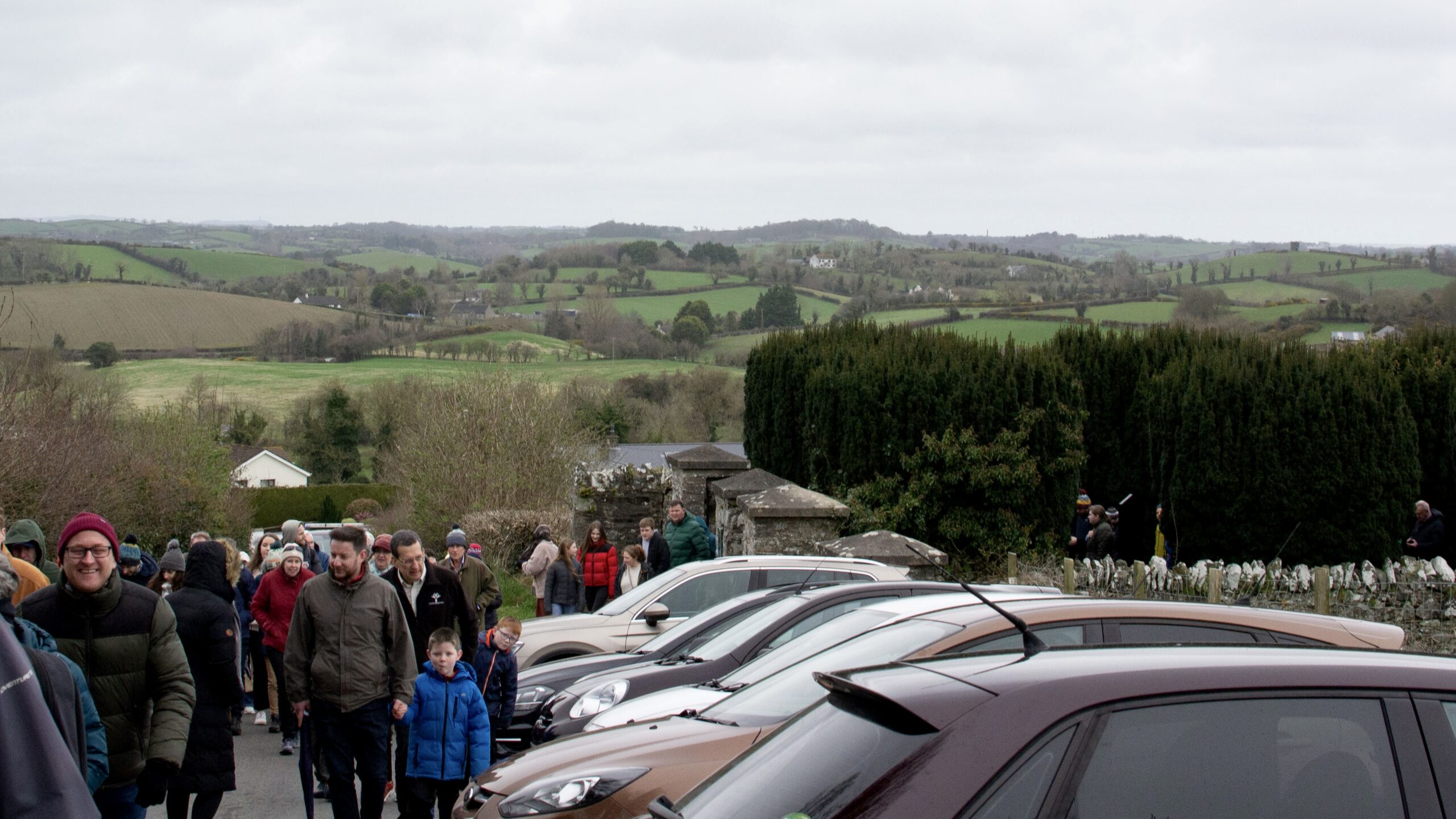
SAUL, Northern Ireland — Divisions along religious lines were heavy on the mind of Georgina Magine as she joined about 150 others for a drizzly prayer pilgrimage in County Down on the eve of St. Patrick’s Day.
“We’re all divided in Northern Ireland, but we all claim St. Patrick,” said Magine, a first-timer at the pilgrimage after having learned about it from a friend.
The annual St. Patrick’s Day Prayer Pilgrimage at Down & Dromore, a Church of Ireland diocese, is a two-mile walk from Saul Church, where tradition has it that St. Patrick established his first church when he visited Ireland in the 4th Century. It concludes at Down Cathedral, where the saint’s purported tombstone is located.
According to tradition, Patrick was kidnapped from his home in Britain at 16 and brought to Ireland. After six years of captivity — where he looked to religion for solace — Patrick escaped back to Britain. But upon returning to his homeland, he experienced a revelation where he was told to go back to Ireland and spread Christianity among the people.
While many St. Patrick’s Day parades involve floats, shamrocks and beer, this one is all about prayer and reconciliation.
After leaving Saul Church, marchers stopped at four different spots along Saul Road to pray, led by Pastor David Leggee, a Christian evangelist and preacher.
“We need repentance and we need to intercede for our land,” he said to the group. “We need to be a generation that seeks the Lord.”
At the second stop, Magine huddled in with a small group of strangers outside of a SPAR Supermarket. As she bowed her head and closed her eyes, she lifted her voice and asked God to bring an end to sectarianism in the country.
Although the Good Friday Agreement put an end to sectarian violence in Northern Ireland, deep divisions over the impact of the conflict linger — dozens of “peace-walls” divide Catholic and Protestant neighborhoods, and less than 10 percent of students in the region attend religiously integrated schools, according to The Council on Foreign Relations. But St. Patrick is foundational to both Protestants and Catholics in the country, and the commonality often plays a role in interfaith initiatives, especially in County Down.
The patron saint of Ireland is believed to have brought Christianity to the country long before the Reformation. And although he wasn’t Irish, his story became closely tied to Irish identity.
Rev. Jackie Breen, an ordained deacon at the Roman Catholic Saul & Ballee Parish, who took part in the day’s festivities, said growing up in County Down around the sites associated with St. Patrick put the saint at the forefront of his own faith journey.
Breen said several members of his own congregation were dispersed among the crowd at the pilgrimage while he stood as a member of the clergy representing Catholics at the ecumenical service following the pilgrimage.
He also noted that Downpatrick is unique to the rest of the country in that there is more harmony between the two faiths. Local churches are accepting of Patrick’s place in both Protestant and Catholic faiths, even throughout The Troubles, he said.
“It was a privilege for me to be there to bear witness of our mutual friendship that has sustained throughout the years, and to give witness to that wider community in Ireland of our acceptance of Patrick’s place in our shared faiths,” said Breen.
Many people make this pilgrimage year after year. Jenny Williams, chief executive of Habitat for Humanity Ireland, is a regular at the prayer walk. “It’s just a really special thing to do on St. Patrick’s Day because Patrick wanted to shine the light of the Gospel in Ireland,” said Williams. “It’s an important thing to do every year to remember that.”
Stephen Rutherdale came to the pilgrimage with his young family. The last time they attended in 2018, it was snowing and his second eldest was only nine months old. Now, they’re a family of six with one more on the way, he said.
“We really enjoy this,” said Rutherdale. “This is a great way to meet up with other people from different churches across the diocese.”
Even as the country has become more secular, with a referendum being signed to end the Catholic Church’s special position in the Constitution in 1975, the St. Patrick’s Day celebrations are still well attended.
The Rev. George Okikiolu said he moved to Northern Ireland from Nigeria 12 years ago to explore cross-cultural ministry. Since then, he’s witnessed a decrease in church attendance, he said. “Faith is being affected with the growing culture and secularism in the community,” said Okikiolu.
In response, this year’s pilgrimage theme was on revival and lighting a fire of the Christian faith in the land of Ireland.
The Rev. Jan Stevenson, community pastor at Ballyholme Parish Church, said the theme parallels a story about St. Patrick who lit a flame on the hill of Tara as an act of defiance against the Druids. She said St. Patrick claimed the fire for God rather than the Druid king, and this fire became a metaphor for Christianity in Ireland.
As people walked out of the service at Down Cathedral, a small bonfire burned to signify the spread of the Christian faith the leaders and believers were longing for.
“We would believe that the fire of Patrick has never been put out,” said Stevenson. “And the Christian faith continues in Ireland.”
